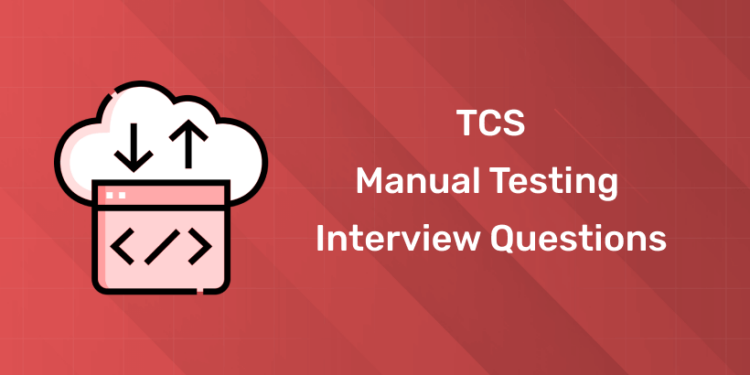Table of Contents
Gearing up for a manual software testing interview? To get that extra edge over other candidates, we have compiled a set of interview questions specifically tailored for TCS. Read on to know more types of questions and answers that you may come across during the interview!
Check out this video by Entri in Malayalam!
Introduction: Manual Software Testing
Manual testing is an important part of the software development life cycle. It’s testing without using any automation tools, to make sure the software behaves as expected. To put it simply, the tester takes on the role of a user and interacts with the software by clicking the buttons and entering information, to check if it is responding in the way it is supposed to. The bugs that cause the software to act differently are written down to be addressed later on.
When comparing with automated testing, manual software testing is slower, but since it is done manually, humans can notice things that may go unnoticed by the automation tools. If you are going for a manual testing interview at Tata Consultancy Services (TCS), knowing the common interview questions and how to answer them will increase your chances of success. This post will help you with preparation tips and TCS manual testing interview questions with answers.
Overview of TCS
1: What is software testing?
Tata Consultancy Services (TCS) is one of the largest IT services, consulting, and business solutions organizations in the world. With a global presence and a wide range of services, TCS offers great career opportunities, including in ETL testing. Working at TCS can give you exposure to the latest technologies, diverse projects, and a collaborative work environment.
Why join TCS as a Manual Tester?
Joining TCS as a Manual Tester has many benefits:
- Career Growth: TCS provides opportunities for continuous learning and career progression.
- Diverse Projects: Work on multiple projects across various industries and gain broad experience.
- Job Stability: TCS is known for its stability and employee-friendly policies.
- Global Exposure: Opportunity to work with global clients and on international projects.
- Cutting-Edge Technology: Access to the latest tools and technologies in the industry.
Master Testing Skills with Industry Experts
Become a Test Engineer: Learn Core Skills from Industry-Leading Mentors and Land High-Paying Testing Jobs!
Explore ProgramPreparation Tips for TCS Manual Testing Interviews
- Basic Concepts: Make sure you have a good understanding of manual testing concepts, types of testing, test case design techniques, and the defect life cycle.
- Review Your Experience: Be prepared to talk about your testing experience, projects you worked on, testing methodologies used, and challenges you faced.
- Practice Common Questions: Familiarize yourself with common interview questions and practice your answers.
- About TCS: Know about TCS’s business model, key clients, and recent projects. This shows your interest in the company.
- Mock Interviews: Do mock interviews with peers to boost your confidence and get feedback on your answers.
Learn Software Testing from QA Experts! Get Free Demo Classes Here!
Top TCS Manual Testing Interview Questions
1. What is Manual Testing?
Answer: Manual testing is testing without using any automation tools to find defects. It ensures the software is bug free and meets the requirements.
2. What are the types of manual testing?
Answer:
- Black Box Testing: Testing without knowing the internal workings.
- White Box Testing: Testing with knowing the internal code.
- Unit Testing: Testing individual components.
- Integration Testing: Testing combined parts of the application.
- System Testing: Testing the whole system.
- Acceptance Testing: Verifying the software meets business requirements.
3. What is software testing life cycle (STLC)?
Answer: STLC includes:
- Requirement Analysis: Understanding the testing requirements.
- Test Planning: Creating the test plan.
- Test Case Development: Writing test cases.
- Test Environment Setup: Setting up the environment.
- Test Execution: Executing test cases.
- Test Cycle Closure: Closing the test cycle and documenting.
4. What is a test case?
Answer: A test case is a set of conditions or actions to verify a specific feature or functionality of the software application. It includes test steps, preconditions, test data, expected results and postconditions.
5. What is a bug or defect in software testing?
Answer: A bug or defect is an error, flaw or fault in the software application that causes it to produce incorrect or unexpected results or behave in unintended ways.
6. What is defect life cycle?
Answer: Defect life cycle includes:
- New: When a defect is found.
- Assigned: Assigned to developer for fixing.
- Fixed: Developer fixes the defect.
- Test: Tester retests the defect.
- Closed: Defect is fixed and closed.
- Reopen: If defect still exists, it is reopened.
7. What is test plan?
Answer: A test plan is a document that outlines the scope, approach, resources and schedule of testing activities. It defines test objectives, test criteria, test deliverables and risk assessment.
8. What is Top-Down Integration Testing?
Answer: Top-down integration Testing is an Integration testing technique in which testing is done by integrating two or more modules by moving down from top to bottom through the control flow of the architecture structure.
- High-level modules are tested first and then the low-level modules are tested.
- Stubs are the modules that act as temporary replacements for the called module.
9. What is a test scenario?
Answer: A test scenario is a high level description of what needs to be tested. It represents a user journey or a specific functionality to be tested.
10. How do you prioritize test cases?
Answer: Test cases are prioritized based on:
- Business Impact: Features critical to business.
- Frequency of Use: Features used frequently.
- Complexity: Features with complex functionality.
- Regulatory Requirements: Compliance related features.
11. What is exploratory testing?
Answer: Exploratory testing is an informal testing approach where testers explore the application without pre defined test cases to find defects through their experience and intuition.
12. What is usability testing?
Answer: Usability testing is testing the user friendliness of an application. It is testing how easily users can navigate and interact with the application.
13. What is regression testing?
Answer: Regression testing is re-testing of already tested functionality after changes or updates to ensure nothing has been broken.
14. What are test deliverables?
Answer: Test deliverables are documents and reports generated during testing, test plans, test cases, defect reports, test summary reports.
15. How do you do risk based testing?
Answer: Risk based testing is testing based on risk of failure and impact. High risk areas are tested more thoroughly.
16. What is boundary value analysis?
Answer: Boundary value analysis is a test case design technique where you test at the boundaries of input ranges to find defects at edge cases.
17. List the differences between the Test Case and Test Scenario.
Answer:
|
Parameters |
Test Case |
Test Scenario |
|---|---|---|
|
Definition |
A test case is a detailed document that provides details about the testing strategy, testing process, preconditions, and expected output. |
A test scenario gives one-line information about what to test and is derived from the use case. |
|
Action Level |
These are low-level actions. |
These are high-level actions. |
|
Objective |
The purpose is to verify the test scenario by implementing the steps. |
The purpose of the test scenario is to cover the end-to-end functionality of software functionality. |
|
Time Consumption |
It takes more time. |
It takes less time. |
|
Input |
It can be obtained from test scenarios. |
It can be obtained from the use case. |
18. What is a test script?
Answer: A test script is a set of steps to test a particular functionality. Manual or automated.
19. What is the difference between verification and validation?
Answer:
- Verification: Ensures the product is built correctly according to specifications.
- Validation: The product meets user requirements and expectations.
20. What is alpha and beta testing?
Answer:
- Alpha Testing: Conducted by internal teams before the product is released to external users.
- Beta Testing: Conducted by few external users to get feedback before final release.
21. List the differences between Regression and Retesting.
Answer:
|
Parameters |
Regression Testing |
Retesting |
|---|---|---|
|
Definition |
Regression testing is done to ensure that the changes have not affected the unchanged part of the product. |
Retesting is done to ensure that the test cases which failed in the last execution are fixed. |
|
Purpose |
To check that the new code changes should not have any side effects on the existing functionalities. |
To check whether the functionality has been restored following a bug fix. |
|
Is Automation possible? |
It is possible as Manual testing can be time-consuming and expensive. |
Automating test cases for retesting is not possible. |
|
Test cases considered |
Regression testing is done for passed test cases. |
Retesting is done for failed test cases. |
|
Defect Verification |
Defect Verification is not part of regression testing. |
It is part of retesting. |
22. What is the role of a tester in agile development?
Answer: In agile development, testers work with developers and stakeholders, participate in sprint planning, create and execute test cases and ensure continuous integration and delivery.
23. What is a Critical Bug?
A critical bug is a bug that tends to affect the majority of the functionality of the given application or software. The software cannot be released unless the critical bug is addressed.
24. How do you handle missed defects in testing?
Answer: Handling missed defects can be done by :
- Conducting root cause analysis.
- Improving test coverage and test cases.
- Enhancing test techniques and strategies.
- Providing additional training to testers.
25. What is test data management?
Answer: Test data management is creating, managing and maintaining test data required to execute test cases. It ensures data integrity and consistency across test environments.
Conclusion: Entri’s Software Testing Course
If you want to be good at manual testing, join Entri’s Software Testing Course. This course covers various testing methodologies, including manual testing. Learn from industry experts and get practical hands-on experience to improve your testing skills. With the dedicated placement cell, this course is your ticket to secure your future. Check out Entri’s Software Testing Course.
Are you aspiring for a booming career in IT? Then check out |
|||
Full Stack Developer Course |
Python Programming Course |
Data Science Course |
Software Testing Course |
Frequently Asked Questions
What is manual testing?
Manual testing is a process of finding defects in a software application without using automation tools. It involves executing test cases manually by a tester to ensure the application behaves as expected.
How do you prepare for a manual testing interview at TCS?
Prepare by understanding basic manual testing concepts, reviewing your past experience, practicing common interview questions, learning about TCS, and conducting mock interviews to improve your confidence.
What types of questions are typically asked in a TCS manual testing interview?
Questions usually cover topics like types of manual testing, test case design techniques, defect life cycle, test plans, test scenarios, and specific experiences related to manual testing.
Why is manual testing important?
Manual testing is important because it allows for human observation, which can uncover issues that automated tests might miss, ensuring a more thorough quality assurance process.
What are some common manual testing techniques?
Common techniques include black-box testing, white-box testing, unit testing, integration testing, system testing, and acceptance testing. Each technique focuses on different aspects of the application to ensure comprehensive testing.
What are the skills for manual testing?
Skills required for manual testing include a strong understanding of software testing concepts, knowledge of different testing techniques, attention to detail, analytical thinking, and good communication skills.












